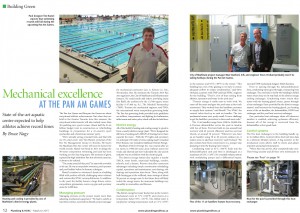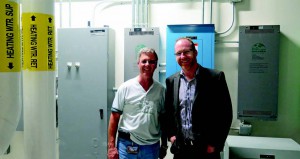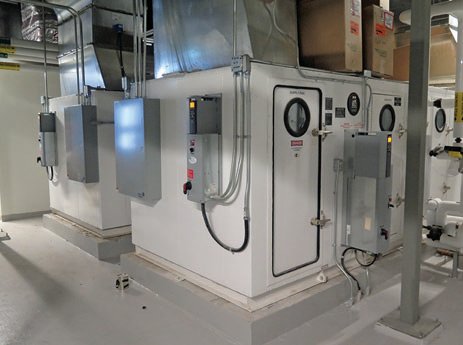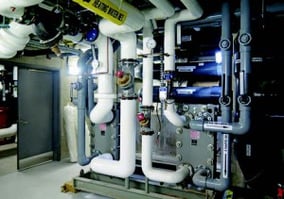As seen on read.uberflip.com - June 2014
 The Pan Am Games and Parapan Am Games are about exceptional athletic achievements. But when they are held in the Greater Toronto Area this summer, the exceptional achievements will also include more than 30 sparkling new sports venues. About half the $1.44 billion budget went to construction or refurbishing buildings in preparation for a 41-country sport spectacular and a boisterous summer party. “We’re already seeing personal bests; and that tells me it’s a fast pool,” says Tim Hamel, principal of the Rec Tec Management Group in Toronto. He hopes the Markham Pan Am Centre will soon be known for world records. Hamel was hired in 2011 to design the 50-metre competition swimming pool and has been working at it for four long years. His moment of glory, captured by high-definition Pan Am television cameras, is about to be realized.
The Pan Am Games and Parapan Am Games are about exceptional athletic achievements. But when they are held in the Greater Toronto Area this summer, the exceptional achievements will also include more than 30 sparkling new sports venues. About half the $1.44 billion budget went to construction or refurbishing buildings in preparation for a 41-country sport spectacular and a boisterous summer party. “We’re already seeing personal bests; and that tells me it’s a fast pool,” says Tim Hamel, principal of the Rec Tec Management Group in Toronto. He hopes the Markham Pan Am Centre will soon be known for world records. Hamel was hired in 2011 to design the 50-metre competition swimming pool and has been working at it for four long years. His moment of glory, captured by high-definition Pan Am television cameras, is about to be realized.
“I’m pretty proud of this pool,” he says with a twinkle in his eye. He was a competitive swimmer, pool operator and pool builder before he became a designer.
Hamel’s creation is a swimmer’s dream in a building filled with positive self-talk, challenging water volumes and noteworthy HVAC accomplishments. In addition to the pool, the facility houses a large fitness centre, competition gymnasium, warm-up gym and spectator
areas for 2,000 fans.
Managing pressure
Managing pressure on the project meant more than adjusting mechanical equipment. “We had to satisfy at least three entities, reported Jon Russill, project manager for mechanical contractor Geo. A. Kelson Co. Ltd., Newmarket, Ont. He mentions the Toronto 2015 Pan Am organizers, the City of Markham and Infrastructure Ontario. He could easily add others providing input like B&H, the architect for the 13,700 square metre
facility (147,460 sq. ft.), The Mitchell Partnership (TMP), Toronto, the mechanical engineer, and FINA, the international swim competition governing body. The Pan Am governing body provided strict guidelines on airflows, temperatures, and lighting for badminton, table tennis and water polo; which will also be held here.
 |
| Heating and cooling is provided by one of Markham’s district energy plants. |
All of the facility’s heating and cooling energy is piped in from a nearby district energy plant. “We’ve designed for 600 tons of cooling and 3,300 kW of heating, but we have capacity for more…With the TV lights and spectators we anticipate 150 watts of extra cooling load,” remarked Peter Ronson, vice president, Markham District Energy.
Markham District Energy Inc. was created after an ice storm in 1998 left some areas without power for weeks and showed just how vulnerable the city and its industry was to problems with the electrical grid.
The district energy station also supplies a nearby YMCA, some hotels, municipal buildings, condos, schools, and a theatre. Ronson describes numerous advantages including simple construction scheduling; capital, operations and maintenance cost sharing; risk sharing; and operations team focus. These, along with bulk buying gas at the wellhead, mean savings of about 50 percent on energy costs. In the future they will likely switch the energy source for numerous buildings very smoothly to renewables, said Ronson.
 |
| City of Markham project manager Max Stanford, left, and engineer Steve Orchard probably won’t be taking holidays during the Pan Am Games. |
The district energy hot water feed arrives in the Centre’s mechanical room at 71°C (160°F) and returns at a temperature below 55°C (131°F). The chilled water is supplied at varying temperatures such as 7.2°C (45°F) in the summer and 9.5°C (49°F) in the winter. “This building has a lot of the glazing so we have to ensure adequate airflow to reduce condensation,” said Steve Orchard, a partner with TMP and lead HVAC engineer for the building. “There’s a lot of heat coming from athletes, spectators and water in the pool area.”
“District energy is really easy to work with. We came off the main and gave the pool team a four-inch connection. They worked from the backflow preventer to supply their systems,” said Russill. “For HVAC the control valves feed up to each air handler. The two mechanical rooms were pretty small. It was a challenge to get the backflow preventers in there and meet code.”
The 11 air handlers range from 2,500 to 24,000 cfm. A Dectron dehumidifier serves the pool in tandem with two of them. Five have built-in run-around heat recovery with 45 percent efficiency and two use heat wheels, at around 70 percent. “Whenever you have an air handler using 30 to 40 percent outdoor air, it makes sense to add heat recovery,” said Orchard. “We also reclaim heat from compressors in a unique way, dumping it into the heating water return.”
 |
| Five of the 11 air handlers feature heat recovery |
Condensing water at 41°C (105°F) feeds into the dehumidification unit and then is discharged at a maximum of 52°C (125°F). It’s a variable volume system with modulating pumps and a differential bypass, reported TMP mechanical designer Mitch Kooistra.
Prior to passing through the dehumidification loop, condensing water goes through a tempering heat exchanger. The cold side is fed by the building’s chilled water return loop on its way back to the district energy cooling exchanger. Condensing water return then mixes with the heating glycol return, passes through a heat exchanger (heat provided by the district energy system) and becomes the heating glycol, pre-heating seven of the air handlers, the dehumidifier, DHW heat exchanger and the pool heat recovery exchanger.
One particular heat exchanger shuts off whenever another is enabled, achieving optimum efficiency, because all of the energy is recovered from the dehumidifier as low-grade heat.
 |
| Heat for the pool is provided through this heat exchanger |
Control systems
The five heat exchangers in the building handle up to 16 million Btu’s. Control valves feed real time data to a Johnson Metasys system. A big monitor in the mechanical room allows staff to check and adjust setpoints and actual temperatures.
“When Pan Am arrives, they completely take over. They bring security and all their own technicians to operate the building,” said City of Markham project manager Max Stanford. “Still, I was advised not to take
a vacation during the Games, just in case.”
He is beaming as he shows visitors through the centre, explaining that it collects storm water in a 110,000- litre cistern and pumps it to the irrigation system. He describes the process of laying timbers beneath a 360- ton crane that lifted eight 170-foot B.C. fir trusses into place above the pool; each weighing more than 86 tons.
The building is also designed as a post-disaster facility says Kooistra. All of the mechanical, electrical, and structural components have to be able to withstand earthquakes and remain operational. “The seismic bracing consists of structurally designed steel pipe racks and equipment bases as well as aircraft cable for ductwork and pipe supports.”
Swimming pool equipment
Hamel went with a dual water system in case of failure and to accommodate two-phase filter backwashing. Two 50 horsepower pumps move four million litres of water through the filters every four hours (16,000 litres per minute). “Filtration makes the water clear, chlorine
makes it safer by killing bacteria. But chlorine is not good for people,” he says. “Swimmers train in the water for 2-4 hours a day.” Therefore, the system uses ultraviolet lamps for disinfection. That kills about 60 percent of the bacteria and minimizes chlorine use.
 |
| The pool water filtration system along with one of the expansion tanks. |
The control system monitors and automatically adjusts temperatures, tank pressures, chlorine levels, PH, water clarity, and chemical tank levels. It triggers the addition of chemicals and sends alerts when incoming and outgoing tank pressures differ by 10 PSI, meaning a backwash is due.
Like many modern competition pools, this one is stainless steel with a concrete bottom. Steel pools can be bolted together in a few weeks and sized very precisely. When Pan Am inspects it the pool cannot be short, but can be up to 20 mm long. The surveyor uses bulkheads, screw jacks, motors and axles to tweak the size. All the mechanical equipment is accessible without draining the pool. Once measurements are verified everything is locked in. “They also check temperatures in 20 positions.
Water at 79°F is ideal for swimmers and the air has to be 2°F warmer,” said Hamel. “If it’s too warm, too cold, or too different, swimmers overheat, have difficulty breathing or experience tightening of muscles.”
Overflow returns are not located in the pool wall. Instead the pool is completely full and overflowing into pool deck gutters located around the perimeter. This eliminates wave bounce off walls, which would hamper swimmers in outside lanes; and it means the pool is continuously skimming.
“This pool is fast because there are no concrete walls and we were able to design swim lanes to the maximum width of 2.5 metres,” says Hamel, his eyes twinkling again. “This pool, this building; records are going to be broken. People are going to achieve excellence.”
If you ask us, they already have.



